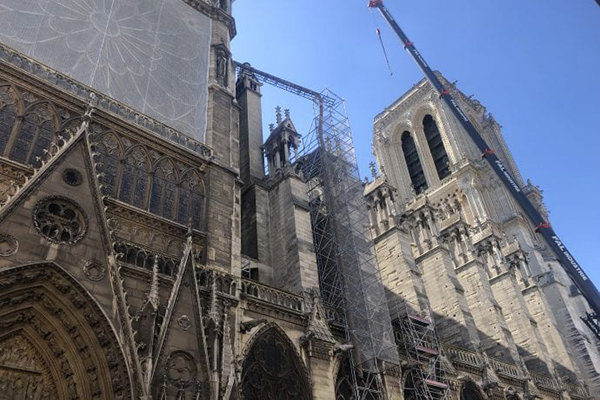
By Christopher White, The Tablet’s National Correspondent
PARIS — For centuries, tourists visiting Paris have stopped along the banks of the Seine to gawk at the Cathedral of Notre Dame. Now, they pause to consider what could have happened – what almost did happen – five months ago, when a fire nearly brought down the 850-year-old landmark.
The once-busy plaza outside the facade, where one could take in sculpted scenes from the creation of the world to the last judgment, is presently filled with construction trailers, scaffolding, and trucks seeking to secure one of the French Church’s most prized treasures.
Yet while the grand cathedral is a religious site, it belongs to the French state, creating one of the first of many challenges as church and state officials face the prospect of restoring Notre Dame.
Monsignor Patrick Chauvet, the rector of Notre Dame, describes his role these days as that of a “diplomat,” serving as the liaison among the archbishop of Paris, the city of Paris, the President of France, and the Ministry of Culture, which is responsible for the restoration efforts.
In the weeks following the April 15 fire, there was a national tug-of-war of sorts between those who wanted to use the restoration to modernize the design of the cathedral and others seeking to return the cathedral to its exact state before the fire.
Despite the drama, Monsignor Chauvet told The Tablet last month that he is enjoying “good relations” with all parties involved, but admitted it’s a delicate process. While he’s of course interested in matters of design, safety, and repair, he’s primarily interested in getting Notre Dame back open as a house of prayer.
“I continue to receive letters from people describing the effects of the fire, and I wish to maintain a new spiritual renewal,” said Monsignor Chauvet.
“I wish that Our Lady can leave the cathedral since we cannot go back inside, but she can go out to meet her children,” he continued, describing how he hopes to place the 14th century statue of Mary outside of the cathedral as a new site of pilgrimage while the restoration efforts are underway.
“We are a religion of the Incarnation. We love to see, so it seems important to me to be able to do such a thing to maintain this flame of spiritual renewal,” he said.
Yet for the estimated 13 million visitors that visit the cathedral each year, many are anxious to know when they will once more be allowed to reenter one of the world’s most iconic churches.
Monsignor Chauvet says the restoration is taking place in three stages.
First – the current phase – is to secure the structure, then a second stage to put in a wooden rooftop, which will allow for scaffolding to be installed atop the cathedral where the original roof once stood, which collapsed during the fire. Finally, the restoration stage will allow carpenters, stonecutters and sculptors to begin the work of restoring it to its state before the fire.
Along the Rue du Cloître-Notre-Dame, which runs parallel to the northern side of the cathedral, a barrier wall separating the cathedral from the once-busy cafés and restaurants that used to line the sidewalk offering the closest spot to enjoy a crêpe while taking in the exterior of the cathedral’s beloved rose window, opinions abound.
One café manager, who asked not to be identified, said that her business is down 70 percent since the fire, and that she’s been struggling from the month the restaurant was closed after the fire.
Yet in the Archdiocese of Paris, whose offices are also parallel to the cathedral, work is slowly beginning to return to normal, even if they remain, literally, in the shadow of the cathedral as a daily reminder of both the tragedy of the fire, but with the hope of what was prevented.
Karine Dalle, Director of Communications for the archdiocese, says that while approximately 750 million euros have been pledged, only a small portion of that has been delivered – adding that Archbishop Michel Aupetit sends his special thanks to the many Americans who have been generous in their gifts.
Dalle, who was with Archbishop Aupetit in the hours when firefighters fought to save the cathedral, says she remembers those images of the fire and smoke every day – but also the scenes of Parisians who stopped in their tracks to watch the cathedral as it was ablaze and who joined in public prayer, first for the cathedral to be spared and then, prayers of thanksgiving for the miracle of it being saved.
“We’re not in crisis management anymore,” she says, assessing the whirlwind of the last five months.
“If you want to think in terms of a television show, we’ve just finished season one and season two is starting,” Dalle continued. “But there will be many more seasons ahead.”
